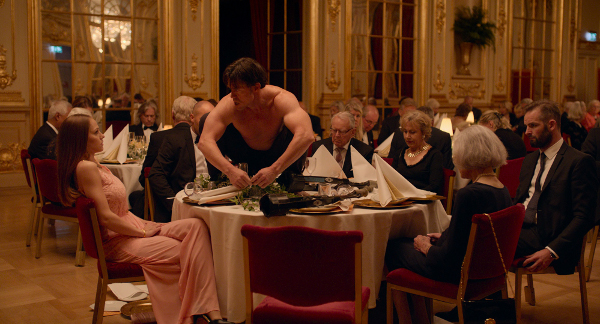
Ruben Ostlund’s Swedish satire THE SQUARE goes after art world, modern hypocrisy
– By Cate Marquis –
Ruben Ostlund’s satire THE SQUARE was Cannes’ Palme D’Or winner this year but this ambitious film is a decidedly unusual winner. Ostlund’s previous film, FORCE MAJEURE, explored a single morally-bad choice in a caustically comic way. THE SQUARE turns a satiric eye on modern art, contemporary society, political correctness, homelessness, sex, income inequality and more, although it often focuses on the subject of trust. THE SQUARE is slyly, darkly satiric and sometimes laugh-out-loud funny, when it is not just downright disturbing. This is not a film for everyone, but it has rewards for those up for its wild ride.
The story revolves around Christian (Claes Bang), the curator at a modern art museum in Sweden. The film’s title refer to a new art installation, a simple square cut into the pavement and edged with an LED light strip, and marked with a plaque reading, “The Square is a sanctuary of trust and caring. Within it we all share equal rights and obligations.” It is a peaceful sentiment, and pretty far from what really goes on in THE SQUARE, once director Ruben Ostlund’s biting social satire gets underway.
Christian’s modern art museum is housed in a historic building adjoining the former royal palace, now also a museum. Redirecting lost tourists to the palace is a daily task for the art museum’s staff. At the film’s beginning, an old bronze equestrian statue is unceremoniously ripped from its pedestal in front of the museum, as the hundreds-year-old brick pavement next to it is sliced into for the new art installation, “The Square.”
Tradition and history don’t get much respect at this museum but money sure does. Like all museums, pleasing donors and the board are a major part of Christian’s job as curator, and drumming up media, and public, interest in the gentle message of the new art installation, by Argentinian artist and sociologist Lola Arias, may be a challenge.
A robbery in which Christian is conned and loses his smart phone and wallet kicks off the series of events that comprise the plot. One of Ostlund’s targets is the media, and its tendency to bring out the worst in people. The gentle message of the art installation has no appeal to the media, which demands “controversy.” While Christian is preoccupied with his own drama over the stolen cell phone and wallet, the PR company cooks up a plan to go viral. The others at the table are clearly uneasy but no one wants to take responsibility for saying no. When the distracted Christian does not object, the plan is launched, with bizarre results. It goes viral and gets media attention all right but not in a good way.
Ostlund underlines modern society’s growing distrust of government by the fact that no one even mentions calling the police after the robbery. Christian and his co-worker’s track his stolen cell phone themselves, and determine where the thief lives.
Christian is the stereotype of the sincere, serious modern man, capable of saying all the right things but clueless about his bubble of privilege. He knows all the right words but just can’t grasp how they relate to him. We first meet the handsome, sincere, well-spoken curator as he is being interviewed by an American journalist named Anne (Elizabeth Moss). As Anne reverently asks him about a self-contradictory statement on the museum’s website, Christian’s answer tips us off as to just how far into the realm of verbal BS this film is willing to wade – which is way into the deep end. The scene is hilarious and telling. Later, they have an equally telling and funny confrontation, in front of an art installation made up of a creaking pile of chairs.
The art world is an easy target but far from the only one in this satire.
READ THE FULL REVIEW AT WE ARE MOVIE GEEKS: